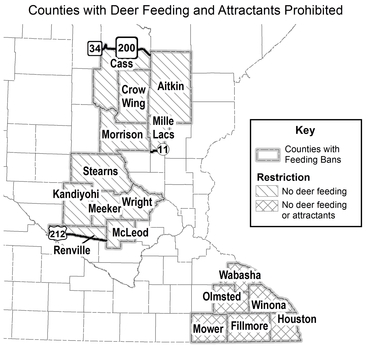|
March 11, 2019
In this issue, read updates on deer open house availability, the reasoning behind why you shouldn’t feed deer during severe winters and get information about the deer feeding bans in effect.

Deer open houses dates and times now available
Information on the deer open houses we promised in the last edition of Deer Notes is now available! Starting March 18, area offices will be dedicating time for conversations about anything deer-related, including last year’s harvest data, potential season changes or the updated Chronic Wasting Disease Response Plan. Find out when you can stop by or call your local office by visiting the Deer Plan webpage.
|
Why the DNR does not recommend feeding deer
As Minnesotans are still digging out from what was the snowiest February on record throughout much of the state, deer enthusiasts may grow concerned about the condition of the white-tailed deer herd and wonder if supplemental feeding is needed to prevent population declines.
Although deer feeding can be well-intentioned, the DNR recommends against it. Why? In short, what we know now is that the risks of these feeding practices easily outweigh the potential benefits. Some examples include:
- Disease risks – The congregation of animals at concentrated sources of feed is known to increase the risk of disease transmission. Because Minnesota has a history of chronic wasting disease (CWD) and bovine tuberculosis in our free-ranging deer populations, practices that would facilitate transmission of disease are not recommended.
- Other health risks – The bacteria, protozoa and fungi that inhabit the stomach of deer comprise a unique and fragile micro-ecosystem. Feeding corn or other high-quality grains to a deer that has been subsisting on very low quality forage for a long time period can lead to a cascade of detrimental health effects including death. Some bagged corn feed has also been documented to be infected with a poisonous and deadly substance called aflatoxin.
- Human safety – Supplemental feeding of any wild animal can lead to habituation. As deer lose their fear of humans, problems associated with deer-vehicle collisions, deer damage to properties and aggressive interactions can arise.
- Effectiveness – Past experience with emergency feeding practices in Minnesota have indicated that the cost is prohibitively high and only a small percentage of the deer herd can gain access to the feed. In much of the state, road access is not adequate for volunteers to effectively canvas deer populations with supplemental feed. Emergency winter feeding has not led to demonstrable improvements in deer populations in the past.
The good news for the Minnesota deer population is that the effects of an occasional severe winter are relatively short-lived. White-tailed deer are a very resilient species with a high reproductive rate, and they can overcome minor setbacks due to severe winters within a few years. Although winters with significant snow depth can reduce deer survival, especially of fawns, deer may fare better because of the early mild conditions this year. Because winter conditions that persist long into spring can also be taxing for deer, the Minnesota DNR will continue to monitor the duration and severity of the winter this year and consider that information as hunting seasons are set later this spring.
We also know that the potential risks to the deer population posed by CWD, a disease with a fatality rate of 100 percent and no known cure or treatment, are long lasting and severe. Given that the practice of emergency deer feeding has no proven population benefits but puts the health of the statewide deer population at risk, this is best decision for the DNR to make for healthy deer populations.

Deer feeding prohibited in some areas
Due to concerns about CWD, deer feeding is currently prohibited in the following counties:
- North central – Aitkin, Crow Wing, Morrison and the portion of Cass County south of Minnesota highways 34 and 200 and the portion of Mille Lacs county north of County Road 11.
- Central – Kandiyohi, McLeod, Meeker, Stearns, Wright and the portion of Renville County north of U.S. Highway 212.
- Southeast – Houston, Fillmore, Mower, Olmsted, Wabasha and Winona.
More information about Minnesota’s deer feeding bans can be found on the DNR feeding ban webpage.
|
|